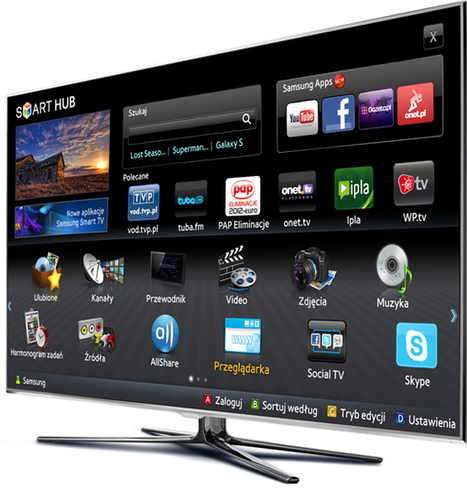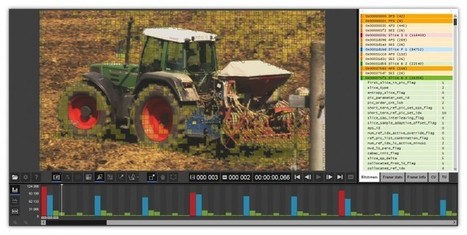 Your new post is loading...
 Your new post is loading...
The transport of HEVC using DASH seems to be a hot topic in media, see for example here, here, here, andhere. In this blog post I'd like to highlight technical changes in order to support HEVC over DASH. The immediate response would be that no updates of DASH are required to support HEVC as DASH is coding format agonistic but the devil is in the detail. In fact, the core DASH specification [ISO/IEC 23009-1:2012] doesn't require any updates but the file format and transport stream standards are currently amended. This may impact DASH as its segment formats are based on the file format and transport stream.
The ITU has approved a new video formatthat could bring 4k video to future broadband networks, while also making streaming HD video available even on bandwidth-constrained mobile networks. The H.265 standard, also informally known as High Efficiency Video Coding (HEVC), is designed to provide high-quality streaming video, even on low-bandwidth networks. The hope is that, through improved compression techniques, H.265 will enable publishers to stream 1080p video with about half as many bits as required today. That should make true streaming HD video available not just in broadband households, but on mobile and tablet devices, using networks that are a lot more bandwidth-constrained. Doing so could make online video more widely available in markets with poor connectivity or mostly mobile connections.
At CES, the pundits worried over the super-high cost of super-high resolution televisions. And then there was the lack of Ultra HD content. But a forthcoming compression standard appears to be the fix and Apple is already in the thick of it.
While today’s price tag for most Ultra High Definition (UHD) televisions are around $10,000, Strategy Analytics expects prices to fall to the sub-$2000 range within the next five years, a factor that will help drive global sales to over 50 million units per year by 2020. The company made these forecasts on the eve of CES 2013 and set the scene for UltraHD to take its bow as possibly the next big thing in TV.
Vanguard Video announces the availability of V.265, a new professional encoder based on the next-generation HEVC (H.265) International Draft Standard. Vanguard Video first demonstrated its HEVC encoder technology at IBC 2012, and now releases V.265 for evaluation by companies involved in high-demand video applications. V.265 can deliver up to 50% reduction in bandwidth and improved video quality compared to that of the existing H.264 standard.
V.265 allows OEMs to determine HEVC's improvements in quality and performance and can take advantage of Vanguard Video's patented video compression technology yielding high-quality video while maintaining real-time operation. In addition, V.265 provides a powerful toolset for offline encoding especially suited for Cloud-based encoding implementations.
A tremendous amount of activity in 2012 also has taken place within video display devices. In a report released in mid-December, Multimedia Research Group (MRG) estimated that the number of shipped units capable—with a software upgrade when available—of HEVC decoding reached 1 billion in 2012. For so many devices to be ready and waiting for HEVC is no mean feat.
The world of sports-video contribution, backhaul, and distribution looks to be on the brink of a major leap forward. New technologies like HEVC (high-efficiency video coding) are set to enter the market, and others, particularly JPEG 2000, continue to carve out a larger share of it. Compression standards and formats like these hold the promise of paving the way for the delivery of next-gen formats like 1080p, 4K, and 8K. An afternoon session moderated by CBS Director of Broadcast Distribution Chris Ehrenbard at SVG’s TranSPORT in New York on Tuesday focused on the evolution of these bleeding-edge technologies and their place in the sports-video landscape.
As consumers increasingly view live and VOD television on a broader range of IP-connected devices, broadcasters are struggling to deliver these high-bandwidth services. However, a new video compression standard called High Efficiency Video Coding (HEVC) promises to improve upon the current compression standard H.264, also known as MPEG-4 AVC, easing broadcasters’ pain. Using HEVC, broadcasters can reduce the data rate needed for high-quality video coding by approximately 50 percent, enabling them to deploy higher quality OTT video services using the same amount of bandwidth, or half the bandwidth at the same quality. In addition to improving OTT delivery, HEVC also has the potential to support a broad range of current and future applications, including 4K x 2K Ultra High Definition Television (UHDTV), making it an extremely exciting technology that pushes the consumer experience to the next level.
Allegro DVT is proud to introduce the world first HEVC hardware decoder IP at IBC 2012. HEVC (aka “High Efficiency Video Coding”) is the next generation video standard, currently being developed by the JCT-VC team. JCT-VC is a joint team between MPEG and VCEG. The new HEVC decoder IP leverages Allegro DVT long and successful history of hardware video IPs development. Thanks to this HEVC decoder IP, Allegro DVT customers will be able to tape-out HEVC capable SoC as soon as the standard is finalized. At IBC 2012, Allegro DVT will demonstrate an FPGA based, real-time, high definition HEVC decoder, on its booth: 1.A46.
Allegro DVT AL1200 and AL2200 are the world first live broadcast encoder and transcoder for HEVC. They are aligned with the latest standard revisions in order to provide glowing video quality, at a fraction of the bandwith required for MPEG-2 and H.264. With support for Transport Stream output and MPEG-DASH, they are well adapted for operators willing to early adopt this new compression standard.
Bitrate savings brought by HEVC allow premium video delivery at resolutions and places that operators and broadcasters were only dreaming of before. Furthermore, most of the delivery pipeline remains untouched, since HEVC will make use of agnostic delivery protocols such as MPEG-2 Transport Stream and MPEG-DASH.
DATASHEET : http://www.allegrodvt.com/broadcast/images/PDF/leaflet_al1200-al2200.pdf
The latest draft of the high-efficiency video coding codec appears to point to early 2013 for the final specification. Last year's MPEG standards buzz was around DASH (dynamic adaptive streaming over HTTP) which provides a standardized way to segment H.264-based MP4 files for fragmented delivery. This year's end-of-year buzz may very well be around the high-efficiency video coding (HEVC) codec set to replace H.264. So how does this move to H.265 impact DASH?
High Efficiency Video Coding (HEVC, ISO/IEC 23008-2) has reached the stage of Draft International Standard (DIS), the next formal stage towards its completion, during the 101st MPEG meeting. HEVC is being developed by the ITU-T/ISO/IEC Joint Collaborative Team on Video Coding (JCT-VC), a joint team of experts from MPEG and the ITU-T’s Video Coding Experts Group (VCEG). The new draft standard shows significantly better compression than the current AVC standard (Rec. ITU-T H.264 | ISO/IEC 14496-10), particularly for the case of high resolution video, where the bit rate savings can be as large as 50% or more for the same visual quality. HEVC, which will be finalized by January 2013 for approval of the first edition of the standard, marks the next generation in the history of video compression and its standardization. Beyond the next edition, substantial extensions are planned to address the demands of additional key applications including professional-use and scalable video coding.
French encoding specialists ATEME claim that their new EAVC4 codec is capable of delivering 4K and even 8K video over IP using current MPEG-4 compression. While ATEME is also a core member of a consortium researching the High Efficiency Video Codec (HEVC)—the successor to MPEG-4 and designed expressly for higher resolutions—it suggests that Ultra-HDTV video transport can be achieved today. ATEME claims that the H.264-compliant EAVC4 codec can deliver a 20% gain in efficiency over previous MPEG-4 H.264 AVC codecs.
|
Elemental Technologies, the leading supplier of video solutions for multiscreen content delivery, today announced support for the next-generation HEVC (high-efficiency video coding) H.265 codec. With a flexible software-based architecture, video processing solutions from Elemental offer support for the new codec via a seamless software upgrade. The bandwidth efficiency associated with the adoption of HEVC promises to greatly expand delivery of high-quality, high-resolution video over bandwidth-constrained networks. Elemental H.265 encoding exhibits bandwidth reductions of up to 50% compared to H.264. Elemental software is format agnostic and enables interoperability with applications and standards vital to multiscreen infrastructures, such as the integration of H.265 into MPEG-DASH workflows featuring H.265-decoding-capable DASH players. H.265 support will be commercially available in Q2’13 on Elemental flagship platforms, including Elemental® Live and Elemental® Server, which deliver high-quality, high-efficiency video processing required for streaming live and on-demand video to any device. H.265 reference streams are available from Elemental today. Elemental will demonstrate concurrent H.264, MPEG-2, and H.265 encoding on a single Elemental® Live system at NAB in April. Elemental will also present a webinar on the topic of HEVC for multiscreen video on February 7. To register for the webinar, click here. To learn more, please click here to visit Elemental’s H.265 microsite anddownload the Elemental H.265 whitepaper.
H.264, we hardly knew ye — except we did and that now veteran format has become part of the foundation for the delivery of high-quality video over the Web. This changes later this year as a new format hits our virtual town,HEVC (High Efficiency Video Coding), which requires even less storage and bandwidth.
The new HEVC (High Efficiency Video Coding) compression standard will give Pay TV operators like Danish cable operator Stofa the opportunity to increase the quality of multi-screen video and that could have important implications for Connected TV. According to Thomas Helbo, CTO at Stofa, “It is an interesting idea to have high quality TV provided as a multi-screen solution to the big screen TV in the living room. Over the next 5-10 years we will see more services change from DVB-C (classic cable television) to IP and at the same time see an increase in the quality requirements for IP video streams.”
Orange will introduce what could be the world’s first HEVC-based service this spring, delivering HD movies to 2013 models of Samsung Smart TVs in France. The innovation coincides with the launch of a new Orange VOD Connected TV service in partnership with Samsung, covering pre-2013 models as well. The company revealed the partnership with Samsung at CES last week and was demonstrating the VOD service on the Samsung booth. A Full HD movie (1080p, 1920×1080 at 24/25 fps) was being played at 3Mbps thanks to the new video codec, which is due to become a standard imminently.
New product suite achieves new levels for ultra-low-bandwidth Internet video – enabling delivery of full HD 3D, StudioHD, and UltraHD (4K Video) : • eyeIO StudioRes. Built to Hollywood's 4K requirements, eyeIO StudioRes delivers UltraHD, studio-grade H.264 videos (10 bit, 4:2:2 video, xvYCC). eyeIO StudioRes is available for both package media and Internet streaming delivery to bring no-compromise pictures to the next generation of 85" and larger UltraHD/4K screens.
• eyeIO.265. Brings eyeIO technology to the coming H.265 HEVC ITU standard and long-term industry efforts.
• eyeOS. The eyeIO video operating system. A superior, true UNIX™ Operating System featuring advanced kernel enhancements achieving ultra-stability, bare-metal virtualization performance, automatic load-balancing transcoding, closed-environment security, elastic scalability, and advanced 4K video processing including native support for the forthcoming Interoperable Master Format (IMF). eyeOS will be available in beta form for larger enterprises in the spring of 2013.
There is an industry consensus that HEVC (High Efficiency Video Coding), the draft compression standard, will have a dramatic impact on the industry thanks to its ability to eventually halve bit rates compared to MPEG-4 AVC (H.264), the current encoding Gold Standard that it will complement but ultimately succeed. And as with all encoding, if you create sufficient extra coding efficiency to halve bit rates then you can also choose to leave bit rates the same but double picture quality, or turn the bandwidth/quality dial to any point in between. Encoder vendors are working towards deployments of the new codec as early as next year, probably starting with multi-screen TV services and fixed line IPTV.
The weather certainly cooperated in Amsterdam this week for the 2012 IBC convention, which grew in both the number of attendees and the significance for streaming media producers. So what was new and interesting for this year's attendees, the majority of which were from western Europe and the United States? From a streaming production standpoint, two areas drove the discussion: Dash and HEVC.
iXS introduces the XCode 6000 ARM processor-based media gateway family – the industry’s first integrated six HD transcoder media processor and the first to deploy the High Efficiency Video Coding (HEVC) together with integrated Multimedia over Coax Alliance (MoCA) 2.0 The XCode 6000 family has set many new innovations and performance benchmarks on the market. These new innovations include: - First media processing gateway to integrate the new HEVC video compression standard to reduce video bandwidth over the current H.264/MPEG-4 AVC broadcasts and also provide support for 4Kx2K resolution. - Multi-format HD decoding engine for flexible media processing of internet Web TV based streaming or Over the Top (OTT) and Over the Top TV (OTTtv) formats. - Best-in-class hardware media processing capable of six concurrent HD transcoding for streaming up to 6 iPads, tablets, smart phones or other connected and mobile devices. [...]
Vanguard Software Solutions (VSS), a leader in H.264/MPEG-4 AVC CODEC technology since 2004, demonstrates a new generation of encoders based on HEVC (H.265), the Draft International Standard approved by the Joint Collaborative Team on Video Coding (JCT-VC) in July 2012. The ISO/IEC Moving Picture Experts Group (MPEG) and ITU-T Video Coding Experts Group (VCEG) established JCT-VC to develop the HEVC standard as a successor to H.264/MPEG-4 AVC. VSS has once again taken the lead by introducing the first HEVC real-time software Encoder SDK for PC. Based on the updated HM-8.0 HEVC reference code, the VSS encoder is optimized for real-time performance on PC platforms, with built-in cloud scalability, while demonstrating improvements in quality and bitrate for video distribution and communication markets over current implementations based on H.264/MPEG-4 AVC. HEVC encodes video at lower bitrates than H.264/MPEG-4 AVC while maintaining similar quality levels.
Technology giant Ericsson has introduced what it claims is the world’s first HEVC encoder unit for live video transmission in particular to mobile devices.
The units tap into the very latest in compression technologies and which could save broadcasters and operators up to 50 per cent in delivery bandwidth, while at the same time boosting download speeds. The encoders comply with the HEVC/H.265 compression algorithms which is now finalised and agreed and will be endorsed as an industry ‘standard’ in January 2013.
READ PRESS RELEASE : http://bit.ly/Sl6hTa
Zond 265 is the first-to-market tool for the visual in-depth analyzing of HEVC/H.265 video bitstreams. It is intended to help video developers and researchers in codec development, easily isolate and identify visual artifacts or problems with bitstream compliance, and see the encoding elements of video data. It shows in a handy way NAL information, frames types, frames sizes, time stamps, decoding/display order counters, bits distribution between frame elements, coding units data, coding units coefficients, predicted partitions, transform partitions, motion vectors, quantizers, different stages of picture decoding - predicted picture, before deblock filtering, after deblock filtering, and final picture.
|
 Your new post is loading...
Your new post is loading...
 Your new post is loading...
Your new post is loading...













![Vanguard Video Announces Availability of World's First Real-Time, Pure Software HEVC Encoder [PR] | Video Breakthroughs | Scoop.it](https://img.scoop.it/a-vkfkquj_uj8UtsmgZ0Izl72eJkfbmt4t8yenImKBVvK0kTmF0xjctABnaLJIm9)


![Allegro DVT Showcases World’s First HEVC Hardware Decoder IP at IBC 2012 [PR] | Video Breakthroughs | Scoop.it](https://img.scoop.it/W0kbhecc-BIEWNlZDC1YPTl72eJkfbmt4t8yenImKBVvK0kTmF0xjctABnaLJIm9)



![Elemental Drives Next-Generation Technology Migration with Support for Newly Approved HEVC/H.265 Codec [PR] | Video Breakthroughs | Scoop.it](https://img.scoop.it/_ipbk2GYGYk-0zgLsSlQ-Tl72eJkfbmt4t8yenImKBVvK0kTmF0xjctABnaLJIm9)












